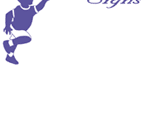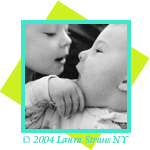|
Milestones
enable parents and physicians to monitor a baby’s learning,
behavior, and development. The term “milestone” takes its name
from a stone marker, placed along the road, that indicates the
distance traveled. The following milestones help to mark
progress along a child’s developmental journey.
While each child develops differently, some differences may
indicate a slight delay and others may be a cause for greater concern. The
following milestones provide important guidelines for tracking healthy
development from four months to three years of age.
Before your child’s next visit to the physician, please
take the time to see if your child
has met his/her
key milestones. These milestones should not be used in place of a
screening, but should be used as discussion points between parents and
physicians at each well visit. If a child does not have the skills listed—or if
there is a loss of any skill at any age—be sure to let your physician know.
Is Your Baby
Meeting These Important Milestones?
Key Social, Emotional, and Communication Milestones
for Your Baby’s Healthy Development
By Stanley I. Greenspan, M.D.
Barry M. Prizant, Ph.D., CCC-SLP
Amy Wetherby, Ph.D., CCC-SLP
and First Signs
© 2004 First Signs, Inc. All rights reserved.
Please do not post,
distribute, or create derivative work based upon these hallmark developmental
milestones without permission of First Signs.
Does Your Baby...
At 4 Months:
- Follow and react to bright colors, movement, and objects?
- Turn toward sounds?
- Show interest in watching people’s faces?
- Smile back when you smile?
At 6 Months:
- Relate to you with real joy?
- Smile often while playing with
you?
- Coo or babble when happy?
- Cry when unhappy?
At 9 Months:
- Smile and laugh while looking at you?
- Exchange back-and-forth smiles, loving
faces, and other expressions with you?
- Exchange back-and-forth sounds with you?
- Exchange back-and-forth gestures with
you, such as giving, taking, and reaching?
At 12 Months:
- Use a few gestures, one after another, to get needs met, like
giving, showing, reaching, waving, and pointing?
- Play peek-a-boo, patty cake,
or other social games?
- Make sounds, like “ma,” “ba,” “na,” “da,” and “ga?”
- Turn
to the person speaking when his/her name is called?
At 15 Months:
- Exchange with you many back-and-forth smiles, sounds, and gestures
in a row?
- Use pointing or other “showing” gestures to draw attention
to something of interest?
- Use different sounds to get needs met and draw attention
to something of interest?
- Use and understand at least three words, such as “mama,” “dada,” “bottle,” or
bye-bye?
At 18 Months:
- Use lots of gestures with words to get needs met, like pointing
or taking you by the hand and saying, “want juice”?
- Use at least
four different consonants in babbling or words, such as m, n, p, b, t,
and d?
- Use and understand at least 10 words?
- Show that he or she knows the names
of familiar people or body parts by pointing to or looking at them when
they are named?
- Do simple pretend play, like feeding a doll or stuffed animal, and
attracting your attention by looking up at you?
At 24 Months:
- Do pretend play with you with more than one action, like feeding
the doll and then putting the doll to sleep?
- Use and understand at least 50
words?
- Use at least two words together (without imitating or repeating) and
in a way that makes sense, like “want juice”?
- Enjoy being next to
children of the same age and show interest in playing with them, perhaps
giving a toy to another child?
- Look for familiar objects out of sight when asked?
At 36 Months:
- Enjoy pretending to play different characters with you or talking
for dolls or action figures?
- Enjoy playing with children of the same age, perhaps
showing and telling another child about a favorite toy?
- Use thoughts and actions
together in speech and in play in a way that makes sense, like “sleepy,
go take nap” and “baby hungry, feed bottle”?
- Answer “what,” “where,” and “who” questions
easily?
- Talk about interests and feelings about the past and the future?
The key
social, emotional, and communication milestones were compiled from the following
sources: Greenspan, S.I. (1999) Building Healthy Minds, Perseus
Books;
Prizant, B. M., Wetherby, A. M., Roberts, J. E. (2000) Communication
Disorders in Infants and Toddlers, In C. Zeanah (Ed.) Handbook of Infant Mental
Health,
Second Edition, New York: Guilford Press; and Wetherby, A.M. (1999) Babies
Learn to Talk at an Amazing Rate, FIRST WORDS Project, Florida State
University.
The authors wish to thank the following people who contributed
to these milestones: Ilene Beal; Frances P. Glascoe, Ph.D.; Rebecca Landa,
Ph.D.;
and Robert H.
Wharton, M.D.
Back to top
Next page =>
|




